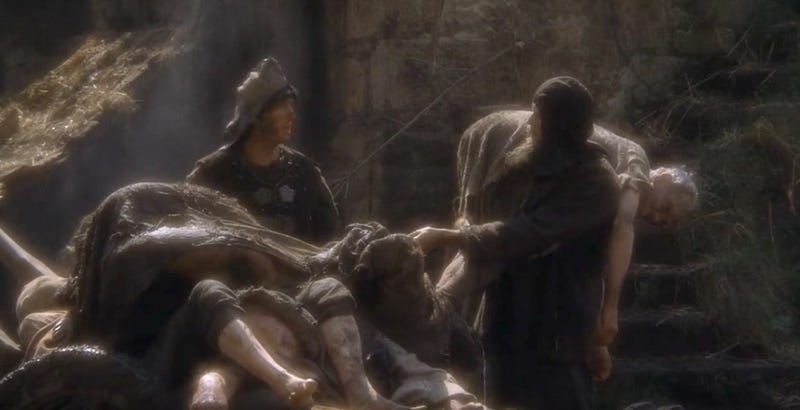
The Black Death, the wave of bubonic plague that devastated Europe after 1348, marked the final end of a long period of economic growth. The several prior centuries had been a time of explosive expansion of both the population and economy of Europe, a development the historian Robert Lopez termed the commercial revolution of the Middle Ages. For the first time since the days of the Roman Empire, commercial markets began to reach deeply across the continent.
The combination of a changing climate, political upheaval, and simply hitting the limits of the agricultural and technological regime brought an end to the salad days of the commercial revolution. Famine on an enormous scale struck Europe hard between 1315 and 1322. The Black Death put a cap on this period of growth, killing somewhere between a third and half of Europe’s population in just a few years. At the same time, a series of devastating wars—the Hundred Years’ War between England and France was just the best known of several—further disrupted trade and the economy.
By 1400, the population had bottomed out at maybe half of its pre-plague peak. With far fewer people living, working, and consuming, economic activity was drastically lower than it had been a century beforehand. The post-plague recession was in full swing.
In this downturn, however, the ground for the next economic explosion after 1500 was being laid. Wages rose and huge swathes of society had more money to spend on consumer goods, from beer to clothing to furniture. With fewer people to feed, the largely agricultural economy could focus more on livestock or specialty cash crops like hops or sugarcane instead of grain. Diets improved and, plague aside, so did health. More and more people were drawn into the market economy and trade networks grew wider and deeper.
At the same time, innovations that had sprung up in the centers of the old economy, like Venice, Genoa, and Bruges, started to spread more widely across Europe. Accounting methods like double-entry bookkeeping left Italy and reached the cities of the Rhineland and England. Banking grew more complex. Credit networks sprang up even among common people in middling towns. Credit instruments like bills of exchange and book transfers became more common: There was more money available for investment at lower interest rates.
Economic institutions to support market exchange spread as well, allowing buyers and sellers of goods to be held accountable for their actions by both informal reputation and legal force. Expanding states helped to integrate markets across entire regions and made it easier and safer to trade. Technological innovations like better ships and the printing press added to the ferment.
These were the ingredients that helped to produce the economic expansion that swept across 16th-century Europe. One more piece sprang up in this period as well, and it still shapes our world today: capitalism. What, exactly, does this mean? Well, it’s complicated. In its most basic form, capitalism is a system in which the owners of capital employ workers for wages, who turn out goods and services for production in the market. Historians have spilled a great deal of ink talking about this, but I’d argue that the second part of that equation definitely began to spread widely in this period, with the first running a bit behind it.
If that sounds interesting to you, check out these two episodes of Tides of History, my new history podcast. In the first, we explore the broad trends of the European economy between 1350 and 1650. In the second, we follow two individuals—one a composite and one a real person—through the economic changes that helped lead to an economic world that was on its way to becoming our own.
As always, I’m Patrick Wyman. You may remember my old show, The Fall of Rome. In Tides, I’m covering not only the fall of the Roman Empire, but also the rise of the modern world, with topics like the rise of the state, the Military Revolution, the beginnings of capitalism, and the Reformation. Think of Tides of History like a TV show that happens to have two seasons running simultaneously.
You can subscribe on Apple Podcasts, iTunes, Stitcher, Google Play, NPR One, TuneIn, and any other podcast app you can think of.
Episode 9 - The Rise of Capitalism and the Early Modern Economic Explosion
Episode 10 - Experiencing the Rise of Capitalism
Further Reading:
Avner Greif, Institutions and the Path to the Modern Economy
Christopher Dyer, A Country Merchant, 1495-1520: Trading and Farming at the End of the Middle Ages
Edwin S. Hunt and James M. Murray, A History of Business in Medieval Europe, 1200-1550
Martha C. Howell, Commerce Before Capitalism in Europe, 1300-1600
Wendy Childs, Trade and Shipping in the Medieval West
David Nicholas, The Later Medieval City, 1300-1500
James M. Murray, Bruges, Cradle of Capitalism, 1280-1390
Robert Duplessis, Transitions to Capitalism in Early Modern Europe
Maarten Prak (ed.), Early Modern Capitalism: Economic and Social Change in Europe, 1400-1800
Richard Lachmann, Capitalists in Spite of Themselves: Elite Conflict and Economic Transition in Early Modern Europe
Reinhold C. Mueller, The Venetian Money Market: Banks, Panics, and the Public Debt, 1200-1500
No comments:
Post a Comment